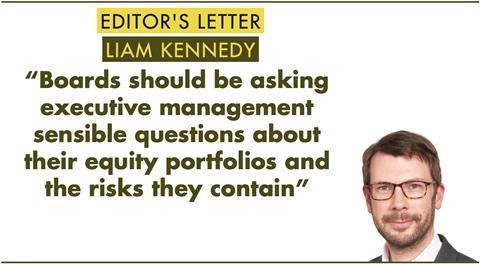We may never know the precise reasons why the in-house equity team of Alecta, the €105bn Swedish pension scheme, chose to invest in excess of €1bn in risky US banks including Silicon Valley Bank (SVB), much of which has now been written off.

With a position of 4.45%, according to CapitalIQ, the Stockholm-based pension fund was the largest active shareholder and the fourth-largest investor overall in the ill-fated bank, after Vanguard, BlackRock and State Street Global Advisors.
But we do know why Alecta chose to have such large positions in single stocks.
Alecta, like some other pension funds, focuses its investment strategy on areas where it has expertise. As it states on its website, its philosophy is based on “in-house analysis, focusing on the absolute return and risk of our investments”.
It continues: “We direct our investment activities mainly to areas where we have such in-house capability and expertise. By limiting the number of holdings we facilitate an even deeper analysis whereby each specific analysis can have a significant impact on our performance.”
Historically, many large institutional investors have embraced index strategies across their asset allocation. This has often been for reasons of diversification under modern portfolio theory – a developed market equities index will contain 1,500 companies; a global aggregate bond index has over 8,000 names.
Index approaches are easy to explain to stakeholders and avoid the risk of selecting the wrong active managers. With increasing focus on asset management fees and costs in recent years by regulators and the public at large, indexation has allowed institutional investors to demonstrate their cost efficiency.
More recently, there have been concerns about corporate governance and accountability in the index investing world. A large-scale passive investor effectively becomes a universal owner, with a small stake in every listed business. In most cases, when it comes to projecting influence on portfolio companies through engagement, many asset owners are only likely to be as effective as their asset managers on aggregate.
This has led to a much greater emphasis on engagement and stewardship by large asset management firms, as well as initiatives to allow investors in pooled funds to exercise voting preferences.
For some pension funds, such as Alecta, the conclusion has been that smaller, active equity portfolios are a solution to the agency problems that arise around the exercise of ownership rights.
And as pension funds come under increasing pressure to ensure their portfolios are on a credible net-zero trajectory, they may also be called on to divest from one or other sector.
Navigating these pressures can be hard, particularly when there is genuine disagreement between those that believe immediate divestment from oil and gas is essential, versus others who assert that portfolio decarbonisation does not equate to real-world CO₂ reduction.
What better way to sidestep these issues by implementing a concentrated portfolio of several hundred global equities that can be aligned to ESG metrics, ideally using an in-house methodology? Bottom-up sector-agnostic portfolio construction can also help avoid the need to have black-and-white sector investment policies.
In the case of Alecta, roughly 44% of its equity portfolio was invested in Sweden, according to the fund’s latest annual report, allowing it to act as a long-term domestic provider of capital in companies it can understand well. Such imperatives are increasingly important in a globalised world of short-term ownership.
PME, the Dutch pension fund for the electronics sector, is among those that have opted for a concentrated approach. PME itself has recently come under fire from a Dutch TV programme that accused it of making misleading statements about fossil fuel divestment.
For its part, Alecta reckons to have lost around 1% of its overall portfolio in SVB and two other US banks. This is far from being an insurmountable loss (the largest six Dutch pension funds lost between 8% and 12.5% on their portfolios before hedging during 2022).
But it is a high-profile embarrassment for Alecta’s board and executive management, one which will lead to scrutiny of institutional equity portfolios and ownership concentrations.
It shows that concentrated equity portfolios are by no means a panacea for pension funds’ concerns about portfolio construction and stewardship. Sound risk management and investment governance will continue to be essential. Trustee boards should be asking executive management sensible questions about their equity portfolios and the risks they contain. If they don’t, regulators and others will probably be asking their own questions soon.
Liam Kennedy, Editor
liam.kennedy@ipe.com


























No comments yet